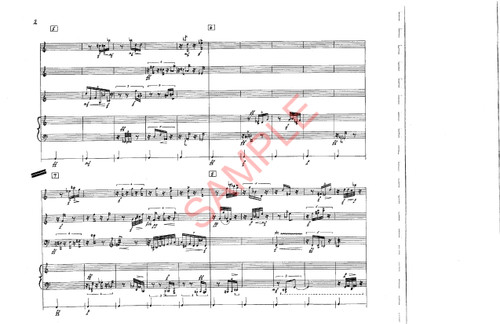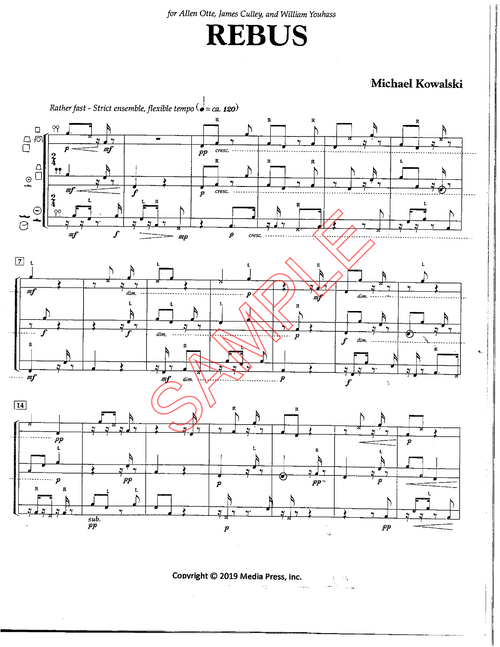Includes score and parts.
Print size: Score- 11 x 14", Parts- 8.5 x 12"
Tracks
1 movement. 7-8 minutes.
Xylophone, glockenspiel, vibraphone, marimba, and piano combine to create a neo-Baroque motor rhythm grounded in a constant quarter-note pulse. Tracks is tonal, but its tonality is grounded neither in modes, post-Romantic or American pop harmony, nor in nostalgic pastiche, but rather in a musical adaptation of the statistical methodology of Markoff chains. My intention was to create the consonant sonority and forward thrust of traditional tonal music without the well-worn melodic and harmonic patterns of tonal music. Whether or not I succeeded is a purely musical question that has nothing to do with an understanding of the mathematics involved.
Tracks was written toward the end of the period of twelve-tone music's hegemony among composers of concert music in the United States. Since then, of course, tonality has reasserted itself in countless forms ranging from minimalism to neo-Romanticism to cross-cultural collage. Tracks represents yet another path, perhaps one not often taken: one that attempts to broaden the unnecessarily narrow sound spectrum of twelve-tone music and restore a lost sense of musical propulsion, while taking care not to throw out twelve-tone music's strange aural magic, its textural inventiveness and indisputable contrapuntal elegance. Serial music happened, and it's in our ears. The fans of Steve Reich can't unhear Pierre Boulez any more than Boulez could succeed in unhearing Wagner or Cage could unhear Beethoven. Tracks is my attempt to straddle the historical divide without waxing nostalgic.
Tracks was composed and premiered in 1974 at the University of Iowa. It was a featured work in the 1978 International Computer Music Conference at Northwestern University. A recording by the University of Michigan Percussion Ensemble with pianist Stephen Thomas is available on the Einstein Records CD Gringo Blaster.
Review from Percussive Notes (2021):
Tracks
Michael Kowalski
I truly enjoy a piece of music that comes together like a tapestry. In this reissue of “Tracks” I am reminded of the rhythmic counterpoint of Boulez and Varèse. The manner in which Michael Kowalski orchestrates these intricate textures is stunning and worth exploring for those who are up for a challenge.
This single-movement work, originally written in 1974, was composed at a time when 12-tone composition predominated the academic landscape. This work features a standard percussion quartet with the addition of piano. In the percussion quartet, three of the parts are written for keyboard instruments with parts calling for marimba, vibraphone, and one part that calls for doubling on glockenspiel and xylophone. The remaining percussion part is written for a trio of unpitched percussion whose job it is to propel the piece forward and outline the overall formal structure. Lastly, the piano part is written in a similar pointillistic fashion common to keyboard percussion, with their inability to sound a true sustain. While the part is predominately rhythmic, the tempo would likely require a trained pianist.
At nearly 7 1⁄2 minutes, “Tracks” would comprise a worthwhile challenge for the advanced undergraduate or graduate percussion ensemble. While its harmonic language is dissonant, its unique use of Markov chains allows for several pleasant yet unexpected simultaneities that are sure to keep the performers and audience actively engaged.
I recommend “Tracks” not only for its historical and aesthetic benefits, but additionally for its consistent use of quintuplet and septuplet subdivisions against a static pulse, which serves a clear pedagogical benefit as well. Kudos to Michael Kowalski on a rewarding piece of music and to Media Press for a well-chosen re-issue.
—Quintin Mallette







